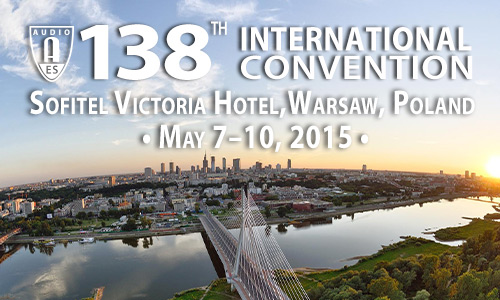
AES Warsaw 2015
Paper Session P3
P3 - (Lecture) Recording and Production
Thursday, May 7, 15:00 — 17:30 (Room: Belweder)
P3-1 Perceptual Evaluation of Music Mixing Practices—Brecht De Man, Queen Mary University of London - London, UK; Matthew Boerum, McGill University - Montreal, QC, Canada; Centre for Interdisciplinary Research in Music Media and Technology (CIRMMT); Brett Leonard, University of Nebraska at Omaha - Omaha, NE, USA; Richard King, McGill University - Montreal, Quebec, Canada; The Centre for Interdisciplinary Research in Music Media and Technology - Montreal, Quebec, Canada; George Massenburg, Schulich School of Music, McGill University - Montreal, Quebec, Canada; Centre for Interdisciplinary Research in Music Media and Technology (CIRMMT) - Montreal, Quebec, Canada; Joshua D. Reiss, Queen Mary University of London - London, UK
The relation of music production practices to preference is still poorly understood. Due to the highly complex process of mixing music, few studies have been able to reliably investigate mixing engineering, as investigating one process parameter or feature without considering the correlation with other parameters inevitably oversimplifies the problem. In this paper we present an experiment where different mixes of different songs, obtained with a representative set of audio engineering tools, are rated by experienced subjects. The relation between the perceived mix quality and sonic features extracted from the mixes is investigated, and we find that a number of features correlate with quality.
Convention Paper 9235 (Purchase now)
P3-2 Automated Equalization of Mobile Device’s Microphones—Przemek Maziewski, Intel Technology Poland - Gdansk, Poland
To achieve high and uniform audio quality in mobile devices their microphones must be equalized. The equalization is typically done manually, requiring lab time, costly equipment, and experienced engineers. This paper presents an automated equalization procedure. It is done using a reference microphone and an external loudspeaker. Each internal microphone is tuned to match the reference microphone’s response to the excitations generated via the external loudspeaker. Additionally, each internal microphone’s equalization is amended with the inverse equalization characteristic of the reference microphone calculated against the chosen reference, e.g., specific certification requirements. This way the final equalization includes both the internal vs reference microphone delta and the correction required for the reference microphone to pass the chosen certification.
Convention Paper 9236 (Purchase now)
P3-3 Use of Audio Editors in Radio Production—Chris Baume, BBC Research and Development - London, UK; University of Surrey - Guildford, Surrey, UK; Mark D. Plumbley, University of Surrey - Guildford, Surrey, UK; Janko Calic, University of Surrey - Guildford, Surrey, UK
Audio editing is performed at scale in the production of radio, but often the tools used are poorly targeted toward the task at hand. There are a number of audio analysis techniques that have the potential to aid radio producers, but without a detailed understanding of their process and requirements, it can be difficult to apply these methods. To aid this understanding, a study of radio production practice was conducted on three varied case studies—a news bulletin, drama, and documentary. It examined the audio/metadata workflow, the roles and motivations of the producers, and environmental factors. The study found that producers prefer to interact with higher-level representations of audio content like transcripts and enjoy working on paper. The study also identified opportunities to improve the work flow with tools that link audio to text, highlight repetitions, compare takes, and segment speakers.
Convention Paper 9237 (Purchase now)
P3-4 Cross-Adaptive Polarity Switching Strategies for Optimization of Audio Mixes—Pedro Duarte Pestana, Catholic University of Oporto - CITAR - Oporto, Portugal; Universidade Lusíada de Lisboa - Lisbon, Portugal; Joshua D. Reiss, Queen Mary University of London - London, UK; Alvaro Barbosa, Catholic University of Oporto - CITAR - Oporto, Portugal
Crest factor is an often overlooked part of audio production, yet it acts as an important limit to overall loudness. We propose a technique to optimize relative polarities in order to yield the lowest possible peak value. We suggest this is a way of addressing loudness maximization that is more sonically transparent than peak limiting or compression. We also explore additional uses that polarity analysis may have in the context of mixing audio. Results show this is a fairly effective strategy, with average crest factor reductions of 3 dB, resulting in equivalent values for loudness enhancement. While still not comparable to the amount of reduction peak limiters are typically used for, the approach is seen as more transparent via subjective evaluation, through a multi-stimulus test.
Convention Paper 9238 (Purchase now)
P3-5 Adaptation and Varying Acoustical Condition and the Resulting Effect on Consistency of High Frequency Preference—Richard King, McGill University - Montreal, Quebec, Canada; The Centre for Interdisciplinary Research in Music Media and Technology - Montreal, Quebec, Canada; Brett Leonard, University of Nebraska at Omaha - Omaha, NE, USA; Stuart Bremner, McGill University - Montreal, Quebec, Canada; The Centre for Interdiciplinary Research in music Media & Technology - Montreal, QC, Canada; Grzegorz Sikora, Bang & Olufsen Deutschland GmbH - Pullach, Germany
The ability to consistently evaluate the frequency response of a music program in a listening room is one of the most fundamental tasks required of an audio engineer. This study requires expert listeners to adjust the high frequency content of audio program under the influence of three different acoustic conditions. The length of exposure is varied to test the role of adaptation on such a task. Results show that there is not a significant difference in the variance of participants’ results when exposed to one condition for a longer period of time. However, some individual subjects exhibit adaptive tendencies within the temporal range tested.
Convention Paper 9239 (Purchase now)
